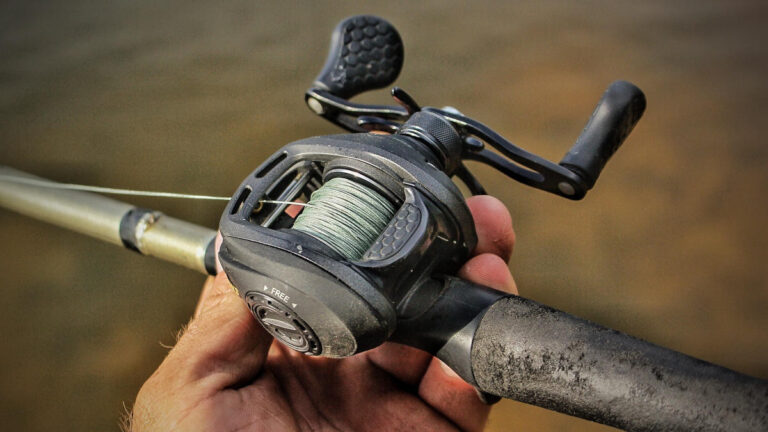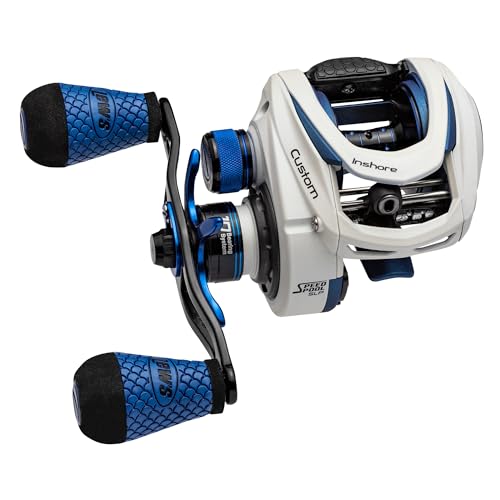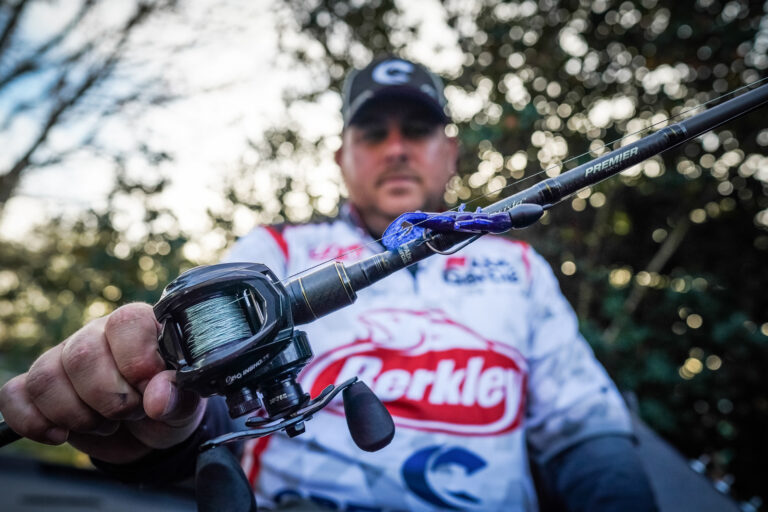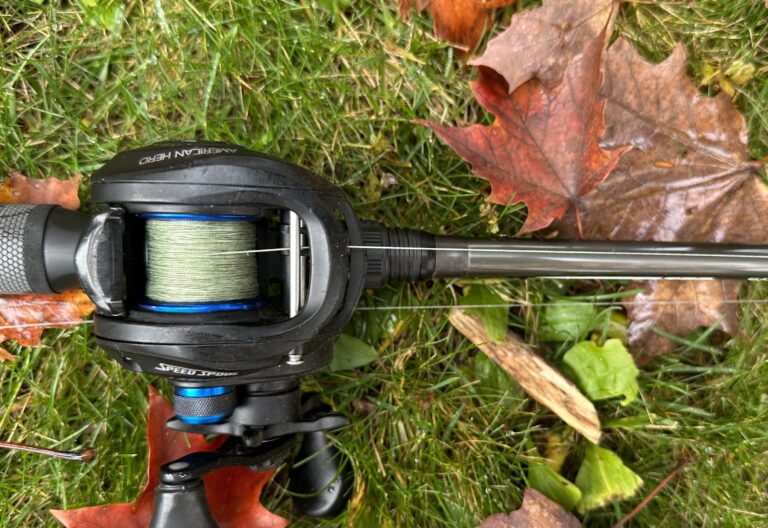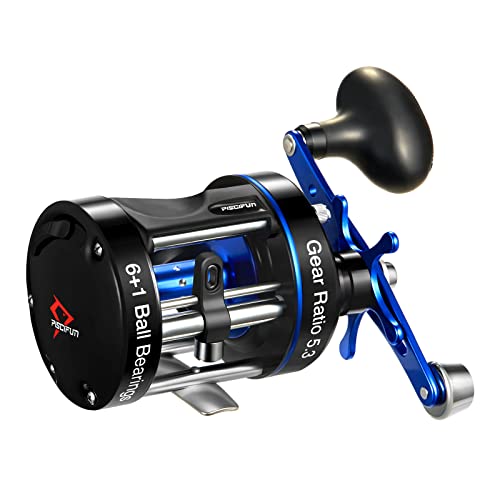Fluorocarbon line is suitable for baitcasting reels due to its low stretch and high sinking ability. It provides excellent sensitivity and is less visible underwater compared to other fishing lines.
Fluorocarbon line is a popular choice for baitcasting reels because of its unique properties. We will explore why fluorocarbon line is considered good for baitcasting reels and how it enhances your fishing experience. We will delve into its low stretch and high sinking ability, which provide numerous advantages for anglers.
Furthermore, we will discuss its exceptional sensitivity and reduced visibility underwater, making it an excellent choice for various fishing conditions. Whether you are a professional angler or a recreational fisherman, understanding the benefits of using fluorocarbon line in your baitcasting reels can greatly improve your chances of success on the water. So, let’s dive in and discover the advantages of fluorocarbon line for baitcasting reels.

Credit: www.amazon.com
The Importance Of Choosing The Right Fishing Line For Baitcasting Reels
The Role Of Fishing Line In Baitcasting Reels
The fishing line is an essential component of baitcasting reels. Choosing the right fishing line can greatly impact your fishing experience and success. Here are some key points to understand about the role of fishing line in baitcasting reels:
- The fishing line provides the connection between the bait or lure and the angler, making it crucial for transmitting signals to detect bites and control the cast.
- It determines the overall strength and durability of your setup, as well as the sensitivity to feel even the slightest nibble.
- Different fishing lines have varying properties such as strength, stretch, visibility, and abrasion resistance, which can affect your fishing technique and target species.
- In baitcasting reels, the fishing line needs to be strong and manageable enough to handle the weight of larger fish and withstand the pressure of casting and retrieving.
Factors To Consider When Selecting A Fishing Line
When selecting a fishing line for baitcasting reels, several factors should be considered to ensure optimal performance and success on the water. Pay attention to the following:
- Line strength: Choose a fishing line with appropriate strength to handle the targeted fish species. Consider the weight range and pound test rating suggested for your baitcasting reel.
- Sensitivity: Opt for a fishing line that offers good sensitivity, allowing you to feel even the slightest nibble or movement underwater.
- Abrasion resistance: Look for a line that has high abrasion resistance, especially if you plan to fish in areas with rocks, vegetation, or structures that may cause friction on the line.
- Manageability: Consider the ease of managing the fishing line when casting, retrieving, and controlling the bait. A line that is less prone to tangling and backlash can contribute to a smoother fishing experience.
- Visibility: Depending on your fishing conditions and target species, choose a fishing line with appropriate visibility. Clear or low-visibility lines can be beneficial in clear water, while high-visibility lines can help you track the line’s movement or detect subtle strikes.
Introduction To Fluorocarbon Line As An Option For Baitcasting Reels
Fluorocarbon line has gained popularity among anglers as a suitable option for baitcasting reels due to its unique properties and advantages. Here are some key points to consider:
- Fluorocarbon line is known for its near-invisibility underwater, making it an excellent choice for situations where fish may be more cautious or easily spooked.
- It has a high abrasion resistance, which can be beneficial when fishing in environments with rocks, timber, or other abrasive structures that could damage the line.
- Fluorocarbon lines offer high sensitivity, allowing you to detect even the slightest bites or movements of your bait.
- With its low stretch, fluorocarbon line provides excellent hook-setting power and enhances your ability to feel the fish’s movements during the fight.
- The density of fluorocarbon lines makes them sink faster than other types of fishing lines, which can be advantageous when fishing at deeper depths or in current.
It’s important to note that fluorocarbon lines tend to be stiffer and less manageable compared to other types of fishing lines, which may require some adjustment to your casting technique. Nonetheless, when combined with the right baitcasting reel setup, fluorocarbon line can be a great choice for various fishing scenarios.
What Is Fluorocarbon Line?
Fluorocarbon line is a popular choice for anglers, especially when it comes to baitcasting reels. It offers several benefits that make it a great option for fishing. In this section, we will delve into the definition of fluorocarbon line, its key characteristics and properties, and the advantages and disadvantages of using it for baitcasting reels.
Definition Of Fluorocarbon Line
- Made from a synthetic material called polyvinylidene fluoride (pvdf), fluorocarbon line is a type of fishing line that is durable and resistant to various environmental factors.
- Fluorocarbon line is known for its high density, low visibility, and sinkability, making it an excellent choice for anglers looking to target fish that are sensitive to line presence.
Key Characteristics And Properties Of Fluorocarbon Line
- Low visibility: Fluorocarbon line is nearly invisible underwater due to its refractive index, making it less likely for fish to detect the line and spook away.
- High abrasion resistance: This type of line is highly resistant to abrasion and can withstand the rough surfaces found in aquatic environments, reducing the risk of breakage.
- Sinkability: Fluorocarbon line sinks faster than other types of fishing lines, allowing bait to reach deeper depths quickly.
- Uv resistance: Unlike some other lines, fluorocarbon line is resistant to damage caused by ultraviolet (uv) rays, making it more durable and long-lasting.
- Sensitivity: Fluorocarbon line provides excellent sensitivity, allowing anglers to detect even the slightest bites or nibbles.
Advantages And Disadvantages Of Using Fluorocarbon Line For Baitcasting Reels
Advantages:
- Improved stealth: The low visibility of fluorocarbon line helps anglers avoid spooking fish, resulting in more successful catches.
- Sensitive detection: With its high sensitivity, fluorocarbon line enables anglers to feel even the subtlest bites, enhancing their ability to react and hook fish.
- Strong abrasion resistance: Fluorocarbon line can handle rough underwater conditions, such as rocks or structures, without easily breaking or snapping.
- Uv resistance: This type of line is less prone to damage caused by exposure to uv rays, ensuring its longevity.
Disadvantages:
- Limited stretch: Compared to other fishing lines, fluorocarbon has less stretch, which may result in reduced shock absorption during fights with larger fish.
- Less manageable: Fluorocarbon line has less flexibility and can be stiffer than other types of lines, making it slightly more challenging to handle and cast accurately.
- Higher price: Fluorocarbon line tends to be more expensive than other lines on the market, which may deter some anglers on a budget.
Fluorocarbon line offers numerous advantages for baitcasting reels, including its low visibility, durability, sinkability, and sensitivity. While it has some drawbacks like limited stretch and higher cost, its benefits often outweigh these considerations for avid anglers. Consider using fluorocarbon line for your baitcasting reels and experience the advantages it brings to your fishing endeavors.
How Does Fluorocarbon Line Perform In Baitcasting Reels?
Baitcasting reels are popular among anglers for their ability to provide precise casting control and power. When it comes to choosing the right fishing line for your baitcasting reel, there are several options available including fluorocarbon line. In this section, we will explore how fluorocarbon line performs in baitcasting reels, focusing on casting distance and accuracy, sensitivity and strength, as well as abrasion resistance and durability.
Casting Distance And Accuracy With Fluorocarbon Line
- Fluorocarbon line is denser than other fishing lines, such as monofilament, which allows for better sensitivity and casting accuracy.
- The low stretch nature of fluorocarbon line ensures that you can feel even the subtlest of bites, resulting in better hook sets.
- Its ability to sink quickly compared to other lines also contributes to improved casting distance, allowing you to reach your target areas more effectively.
Sensitivity And Strength Of Fluorocarbon Line
- Fluorocarbon line offers excellent sensitivity, providing you with a better feel for what’s happening under the water.
- This sensitivity allows you to detect even the slightest nibbles, increasing your chances of a successful catch.
- Additionally, fluorocarbon line is known for its high strength, making it suitable for targeting larger fish species.
Abrasion Resistance And Durability Of Fluorocarbon Line
- Fluorocarbon line has strong abrasion resistance, making it ideal for fishing in areas with sharp rocks or rough surfaces.
- It is less susceptible to damage compared to other fishing lines, providing a longer lifespan and reducing the need for frequent line changes.
- The durability of fluorocarbon line ensures that it can withstand intense battles with fish without compromising its overall strength and performance.
Fluorocarbon line offers various advantages when used in baitcasting reels. Its casting distance and accuracy are improved, while its sensitivity and strength make it a reliable choice. Additionally, the abrasion resistance and durability of fluorocarbon line ensure its longevity, making it an excellent option for anglers seeking a reliable fishing line.
Whether you’re a beginner or an experienced angler, consider giving fluorocarbon line a try in your baitcasting reel setup.
Fluorocarbon Line Vs. Monofilament Line For Baitcasting Reels
When it comes to choosing the right fishing line for your baitcasting reel, there are a few options to consider. Fluorocarbon line and monofilament line are two popular choices among anglers. Each has its advantages and disadvantages, so it’s important to understand the differences before making a decision.
In this section, we will compare fluorocarbon line and monofilament line for baitcasting reels.
Differences In Visibility And Stealthiness
- Fluorocarbon line:
- Low visibility underwater due to its refractive index, making it less likely to spook fish.
- Highly resistant to uv rays, which helps maintain its invisibility and durability over time.
- Ideal for fishing in clear or heavily pressured waters where stealthiness is crucial.
- Monofilament line:
- Offers higher visibility due to its reflective nature, which can be advantageous in certain situations.
- Can be easily seen by fish, especially in clear water or when targeting skittish species.
- Better suited for low-light conditions or situations where visibility may aid in attracting fish.
Stretch And Sensitivity Comparison
- Fluorocarbon line:
- Minimal stretch compared to monofilament line, providing better sensitivity and improved hooksets.
- Allows anglers to feel subtle bites and changes in bottom structure.
- Enhanced sensitivity helps detect even the slightest movements, increasing the chances of a successful catch.
- Monofilament line:
- Offers more stretch than fluorocarbon line, which can act as a shock absorber when fighting aggressive fish.
- Increased stretch can make it more forgiving when setting the hook, reducing the risk of line breakage.
- Provides less sensitivity compared to fluorocarbon line, making it harder to detect subtle strikes or bottom structure variations.
Knot Strength And Ease Of Use
- Fluorocarbon line:
- Known for its exceptional knot strength, ensuring secure connections between line, bait, and terminal tackle.
- Although slightly stiffer than monofilament line, it is still relatively easy to handle and knot.
- Requires attention during knot tying to avoid potential line damage caused by friction or heat.
- Monofilament line:
- Offers good knot strength, although not as strong as fluorocarbon line.
- More pliable and flexible than fluorocarbon line, making it easier to handle and tie knots.
- Less prone to damage from knot tying mistakes, allowing for quick and hassle-free adjustments on the water.
Both fluorocarbon line and monofilament line have their unique characteristics and applications when used with baitcasting reels. Fluorocarbon line excels in stealthiness, sensitivity, and knot strength, making it an excellent choice for clear waters and finesse fishing. On the other hand, monofilament line offers advantages in visibility, forgiveness, and ease of use, making it suitable for various fishing conditions.
Ultimately, the choice depends on personal preferences, the fishing environment, and the specific angling techniques employed.
Fluorocarbon Line Vs. Braided Line For Baitcasting Reels
Fluorocarbon and braided lines are two popular choices for baitcasting reels. Both lines have distinct characteristics that make them suitable for different fishing scenarios. In this section, we will compare the strength and diameter, sensitivity and visibility considerations, as well as fishing applications and specific scenarios for each line.
Strength And Diameter Comparison
- Fluorocarbon line offers excellent strength and durability. It has a higher tensile strength compared to braided line of the same diameter. This makes it an ideal choice for targeting large and powerful fish.
- On the other hand, braided line is known for its incredible strength-to-diameter ratio. It can have a much higher tensile strength compared to fluorocarbon line of the same diameter. This makes it perfect for situations where strength and casting distance are crucial.
Sensitivity And Visibility Considerations
- Fluorocarbon line has a higher sensitivity than braided line. It is less likely to stretch, resulting in better sensitivity and improved bite detection. Additionally, its low visibility underwater makes it ideal for fishing in clear water conditions or when targeting finicky fish.
- Braided line, due to its high visibility, allows anglers to detect subtle line movements and bites more easily. This makes it a great choice for fishing in low-light conditions or areas with heavy cover where bite detection is essential.
Fishing Applications And Specific Scenarios For Each Line
Fluorocarbon line:
- Perfect for finesse fishing techniques such as drop shotting, shaky heads, and wacky rigging. Its low visibility and increased sensitivity allow for more precise presentations.
- Well-suited for fishing in clear water, where stealth is crucial. Its nearly invisible nature makes it difficult for fish to detect the line, increasing the chances of getting a bite.
- Ideal for bottom fishing techniques, as it sinks faster than braided line. This helps maintain contact with the bait and detect subtle bottom structure.
Braided line:
- Excellent for fishing heavy cover such as weeds, lily pads, and submerged logs. Its high strength and abrasion resistance allow anglers to haul fish out of dense vegetation with minimal risk of breaking the line.
- Suitable for topwater fishing techniques such as frogging and walking the dog. Its high visibility makes it easier to track the movement of the lure and react to explosive strikes.
- Great for situations where long casting distances are required. The thin diameter and superior casting capabilities of braided line allow for extended casts with minimal effort.
Whether you choose fluorocarbon or braided line for your baitcasting reel, it ultimately depends on your fishing style, target species, and the specific conditions you’ll be fishing in. Both lines have their advantages and excel in different scenarios. By understanding their strengths, weaknesses, and applications, you can make an informed decision and maximize your fishing success.
Is Fluorocarbon Line Good For Baitcasting Reels?
Baitcasting reels are a popular choice among anglers due to their superior casting control and ability to handle heavier lines. When it comes to choosing the right line for your baitcasting reel, one option to consider is fluorocarbon line. But is fluorocarbon line really good for baitcasting reels?
Let’s delve into the advantages and disadvantages of using fluorocarbon line and when it is recommended to use it.
Summary Of The Advantages And Disadvantages Of Using Fluorocarbon Line
Fluorocarbon line offers several advantages that make it a suitable option for baitcasting reels. Here are the key points to consider:
- Low visibility: Fluorocarbon line has a refractive index similar to that of water, making it nearly invisible underwater. This can greatly improve your chances of fooling wary fish.
- Abrasion resistance: Fluorocarbon line is known for its high abrasion resistance, allowing it to withstand encounters with rocks, structure, and rough surfaces. This durability ensures a longer lifespan for your line.
- Sinks rapidly: Unlike monofilament, which tends to float on the water’s surface, fluorocarbon line sinks quickly. This feature is especially beneficial when fishing in deeper waters or when targeting bottom-dwelling species.
Despite its advantages, fluorocarbon line does have some drawbacks that should be considered:
- Price: Fluorocarbon line is generally more expensive than other types of fishing line, such as monofilament or braided lines. This cost may be a factor to consider, especially for anglers on a budget.
- Stiffness: Fluorocarbon line is stiffer than other lines, which can affect casting distance and accuracy, especially for beginners. It may take some practice to get used to casting with fluorocarbon line.
- Less forgiving: Fluorocarbon line has less stretch than monofilament, which means it doesn’t absorb shock as well. This can make it more susceptible to breakage if you’re not careful.
Recommendations For When To Use Fluorocarbon Line In Baitcasting Reels
To maximize the benefits of fluorocarbon line, here are some situations where it is particularly useful:
- Clear water conditions: Fluorocarbon line’s low visibility makes it an excellent choice for fishing in clear water, where fish are more likely to be spooked by visible lines.
- Bottom fishing: If you’re targeting species that dwell near the bottom, fluorocarbon line’s quick sinking properties make it an ideal option. It helps to keep your bait or lure at the right depth.
- Structure or cover: When fishing in areas with rocks, weed beds, or other structure, fluorocarbon line’s abrasion resistance helps prevent line breakage and allows you to fish closer to potential hiding spots.
Final Thoughts And Considerations For Choosing The Right Fishing Line
Choosing the right fishing line for your baitcasting reel is crucial for a successful fishing experience. While fluorocarbon line offers several advantages, it may not be the best choice in every situation. Consider the following factors when making your decision:
- Fishing conditions: Evaluate the water clarity, target species, and fishing techniques you’ll be using to determine if fluorocarbon line is the right fit for your needs.
- Budget: Take into account the cost of fluorocarbon line compared to other options and decide if it aligns with your budget.
- Personal preference: Ultimately, the best fishing line for your baitcasting reel will depend on your personal preferences, experience, and fishing style. It’s worth experimenting with different lines to find what works best for you.
Fluorocarbon line can be a valuable addition to your baitcasting reel arsenal, providing benefits such as low visibility and abrasion resistance. However, it’s important to weigh these advantages against its higher price tag and potential casting challenges. By considering the fishing conditions and your personal preferences, you can make an informed decision on whether fluorocarbon line is right for you.
Happy fishing!
Conclusion
Overall, it can be concluded that fluorocarbon line is a good choice for baitcasting reels. Its unique properties, such as low visibility, high sensitivity, and abrasion resistance, make it an ideal option for anglers looking for more success on the water.
The low stretch feature of fluorocarbon line allows for better hook sets and increased sensitivity, enabling anglers to feel even the slightest nibble. Additionally, the fluorocarbon line’s density ensures that it sinks faster, making it suitable for various fishing techniques, especially when targeting deep-water fish species.
While fluorocarbon line may be more expensive than other options on the market, its durability and overall performance make it a worthwhile investment for serious anglers. With proper care and maintenance, fluorocarbon line can provide anglers with a reliable line that increases their chances of landing that prized fish.
Whether you are a professional or recreational angler, consider giving fluorocarbon line a try on your baitcasting reel to enhance your fishing experience.

